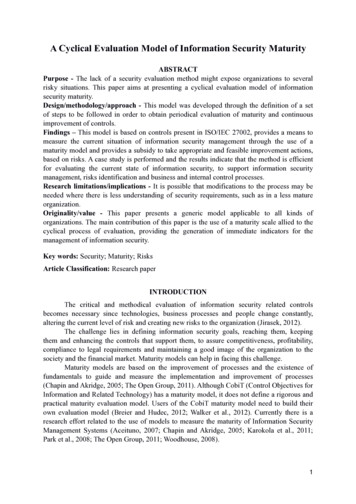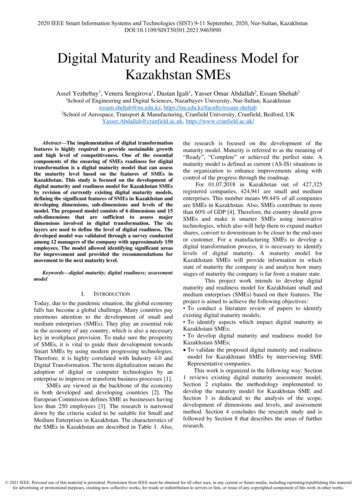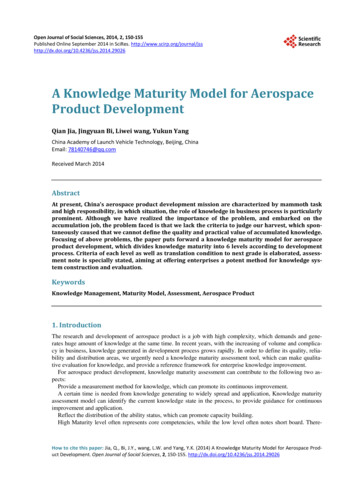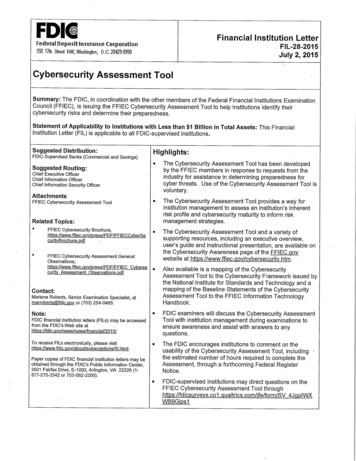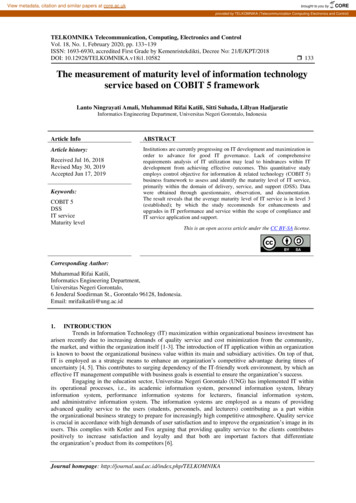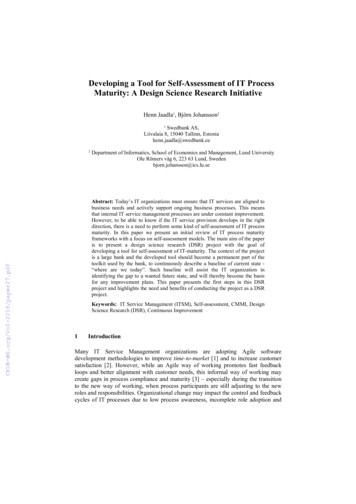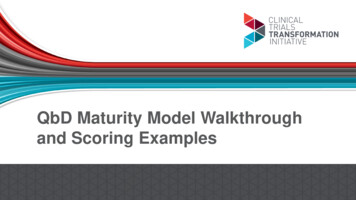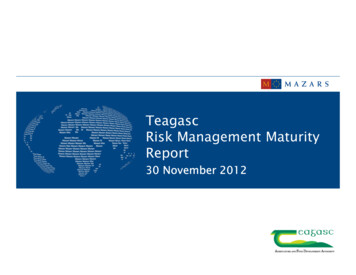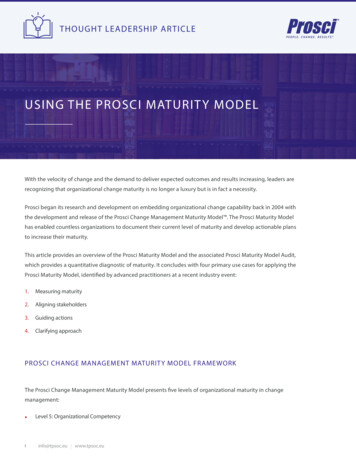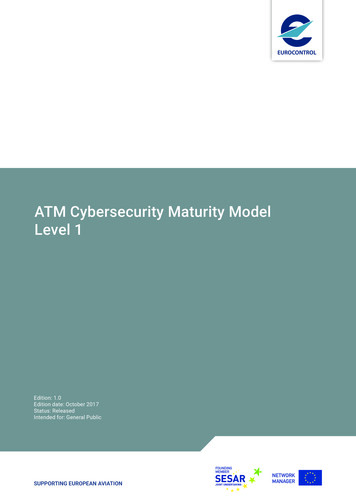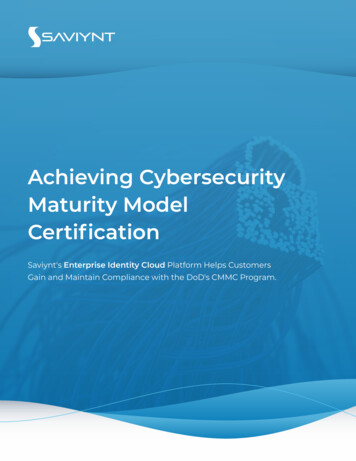
Transcription
Achieving CybersecurityMaturity ModelCertificationSaviynt's Enterprise Identity Cloud Platform Helps CustomersGain and Maintain Compliance with the DoD's CMMC Program.
ContentsIntroduction1The CMMC Program Requirements for Contractors1Saviynt Enterprise Identity Cloud: An Integrated Platform for3Achieving CMMC ComplianceSoftware Integrations Improve Speed and Accuracy4Governance Across the Entire Identity Lifecycle5Privileged Access Only Where and When It’s Needed5Securing and Governing Data Access6Conclusion6Sources6About Saviynt6
IntroductionThe Cybersecurity Maturity Model Certification (CMMC) is a United States Department of Defense (DoD) security frameworkdesigned to prevent the exfiltration of Controlled Unclassified Information (CUI) and Federal Contract Information (FCI) fromcontractors and subcontractors within the Defense Industrial Base (DIB). This paper details how Saviynt's Identity Governanceand Administration (IGA) platform helps customers gain and maintain compliance with the CMMC.Cybersecurity is a top priority for the Department of Defense because its contractors and subcontractors in the DIB areincreasingly targets of frequent and complex cyberattacks. The DoD developed CMMC 2.0 as a dynamic certificationprogram to enhance DIB cybersecurity posture — the program protects sensitive unclassified information shared by theDepartment with its contractors and subcontractors. By incorporating a set of cybersecurity requirements into acquisitionprograms, the CMMC program provides the DoD with increased assurance that contractors and subcontractors meet theserequirements.The CMMC Program Requirements forContractorsThe CMMC operates in a tiered model that requires DIB companies to meet different levels of compliance based on the typeand sensitivity of the information they possess on their unclassified networks. In November 2021, the DoD announced itslatest iteration, CMMC 2.0, which collapsed the previous five-level model down to three. CMMC 1.0 requiredgovernment-approved third-party assessor certifications for all levels; CMMC 2.0 allows Level 1 and some Level 2 companies todemonstrate compliance through annual self-assessments. Level 2 and Level 3 DIB companies handling sensitive CUI datawill require third-party assessments every three years.CMMC consists of 17 security domains with focus areas such as:Access ControlAudit and AccountabilityIdentification and AuthenticationRisk Management
Within each domain are practices or controls derived from NIST 800-171 for Levels 1 and 2 and NIST 800-172 for Level 3. As ofDecember 2021, the DoD has yet to publish how the previous CMMC 1.0 practices realign to the 2.0 three-level model or thenew NIST 800-172 practices. CMMC 2.0 will not be a contractual requirement until the DoD completes its rulemaking process,estimated to take 9-24 months.54321AdvancedProgressiveProactiveGood CyberHygieneIntermediateCyber HygieneBasic CyberHygieneThe CMMC practice levels are all NIST 800-171 controls previously outlined in CMMC 1.0. All NIST 800-171 controlsare expected to be retained with CMMC 2.0, but the DoD has not specified how they will realign to thethree-level model or the new NIST 800-172 based practices.The principles of Identity Governance and Administration (IGA) occupy a significant portion of the practice requirementswithin the CMMC framework. IGA enables a zero-trust model of Identity Governance, ensuring users only have access to whatthey need, for the time they need it, and nothing more. This zero-trust model includes access to IaaS, SaaS, PaaS, andtraditional on-premises resources for human and non-human entities such as bots, Internet of Things (IOT), and RoboticProcess Automation (RPA).
Saviynt Enterprise Identity Cloud: An IntegratedPlatform for Achieving CMMC ComplianceSaviynt Enterprise Identity Cloud (EIC) is built in the cloud, for the cloud, and is the only FedRAMP authorized SaaS solutionfor Identity Governance and Administration (IGA) and Cloud Privileged Access Management (CPAM). The fundamentals ofIGA align closely to the requirements outlined in Federal Identity Credential and Access Management (FICAM).Saviynt EIC is a modular, converged cloud platform developed entirely in-house using a single code base without bolted-onsolutions from third-party acquisitions to complicate the implementation process. Each solution can operate independently,allowing customers to select the product that suits them – and integrate EIC with existing solutions.3RD -PART YAccessManagementDATAPRIVILEGEDIDENTIT YAPPLICATIONAccessManagementGovernance iynt EIC includes the following solutions:Identity Governance andCloud Privileged AccessAdministration (IGA)Management (CPAM)Ensures that users have seamless access and yourProvides complete privileged access protection to supportorganization is in continuous compliance. Increasesongoing business transformation and scale as your businessorganizational efficiency and agility through automation andneeds evolve. Gain visibility and governance for every identityintuitive identity workflows. Powered by a comprehensiveacross your entire environment to improve your securityidentity warehouse and user experience to drive frictionlessposture and maintain compliance. It’s fast to deploy and easyaccess, Saviynt IGA enables Zero Trust in your hybrid andto manage, so you realize value on day one. CPAM can limitmulti-cloud environment.users' actions in the end systems, and session recordingprovides an auditable record of the activities executed.
Application AccessData AccessGovernance (AAG)Governance (DAG)Protects sensitive application access and satisfies governance,Discovers, analyzes, and protects sensitive structured andrisk, compliance (GRC) requirements. Get comprehensiveunstructured data – regardless of whether your IT ecosystemcapabilities in Separation of Duty (SoD) analysis, emergencyis on-premises, hybrid, or cloud-based.access management, role engineering and management,compliant provisioning, and access certification.Third-Party AccessGovernance (TPAG)Securely manages third parties throughout the engagementlifecycle. Internal and external sponsors shepherd the accountfrom inception, through access management, periodic reviews,and eventual decommissioning.The following sections detail how Saviynt enables customers to get and stay compliant within the various CMMC domainsand practice levels.Software Integrations ImproveSpeed and AccuracySaviynt has many built-in integrations for the rapid onboarding of users and applicationsin IaaS, SaaS, PaaS, and on-prem environments. As accounts get onboarded from variousapplications and endpoints, Saviynt's reconciliation rules match up the accounts andentitlements with the user identities gathered from the authoritative sources such as HRM/ ERM applications like Workday, SAP, Oracle, Peoplesoft, Active Directory, and others.Saviynt's identity warehouse becomes a single source of truth (SSOT) that identifies all the access entitlements at the userlevel. Being the central repository for all identity and access-related information enables Saviynt to enforce complexGovernance, Risk, and Compliance (GRC) verifications. Peer group analyses compare individual entitlements to othermembers within the organization that possess the same roles or attributes to identify outlier access that doesn't adhere totypical requirements for that user type. Separation of Duties (SoD) analysis identifies risky combinations of access (e.g.,creating a contractor organization and paying them). These capabilities apply to new access requests as well. As new accessis requested, Saviynt identifies outlier entitlements and SoD violations and displays them to the approver so they can makeinformed decisions in their approval process.Access certification campaigns provide a continuous process that establishes owners of users or applications responsiblefor recertifying access that has been granted. These campaigns can be scheduled at user-defined intervals or automaticallygenerated based on changes in the environment (e.g., user role changes or location changes).
Governance Across the EntireIdentity LifecycleSaviynt's IGA solution establishes a Zero Trust, least privilege, identity model byensuring that all users go through a documented approval process — which identifiesinappropriate privileges and risks associated with new and existing access throughpeer group analysis and SoD verifications.One of the most critical aspects of the Saviynt IGA solution is establishing ownershipof users and applications. Saviynt provides highly customizable, multi-level approval workflows that correlate usermanager and system owner access to various end systems. This includes access to third-party and non-human identitiessuch as bots, IOTs, and RPAs. Ongoing scheduled and automated access recertification campaigns continually verify thatgranted access is appropriate.Highly privileged access has its own approval process and has additional keylogging and session recording capabilities forenhanced oversight of actions performed to organizational systems.Privileged Access Only Where andWhen It’s NeededFor users that require privileged administrative access, Saviynt's Cloud PrivilegedAccess Management (CPAM) solution provides time-bound credentialed andcredential-less access with granular controls on the actions users can perform. CPAMprevents users from performing non-approved actions with screen notificationsadvising of the prohibited action. User connections can be automatically terminatedwhen these prohibited actions are attempted. Keylogging and screen recordingprovides an auditable record of all actions performed.These capabilities all translateinto the zero-trust principles of enforcing least privilege access and ensuring no standingprivileges for critical IT resources.The Saviynt CPAM solution stores privileged account credentials within a built-in HashiCorp vault and is unavailable to theend-user. Users must be approved for privileged access to specific endpoints and authenticate the PAM system to checkthe credentials and connect to the end system. The passwords are immediately reset upon the session's completion.Saviynt CPAM ensures no standing access to system management functionality. It terminates connections to endpointsafter specified timeframes, periods of inactivity, or when users attempt prohibited actions. All actions are logged andrecorded, including permitted and prohibited actions that may have been attempted to establish an auditable record of allactions performed by a particular user in the end system.
Securing and GoverningData AccessSaviynt's Data Access Governance discovers, analyzes, and protects sensitive data bytying identity to authorized access in file sharing solutions such as Box, SharePoint,Oracle, and others. Built-in and configurable regular expression-based scanning rulesprovide the capability to identify documents with sensitive information and pair useridentity to the authorization to view such files.Saviynt has a customizable approval process for granting access to different systems within an organization, includinghaving multiple levels of approval for sensitive systems. Saviynt's Data Access Governance further ties user identity toauthorized access to Federal Contract Information systems.ConclusionSecuring and GoverningGettingahead Accessof the shift and finding ways to meet the requirements will be critical for contractors hoping to continueDataThe growth of cloud computing and the recent shift to blended work environments have been a boon to cyberattackers.CMMC standards are vital for the future of data security in the public sector and for contractors that work for the public sector.working in the federal sphere. Saviynt Enterprise Identity Cloud has many essential features to help contractors achieve andmaintain compliance with the DoD’s CMMC program.About SaviyntSaviynt’s Enterprise Identity Cloud helps modern enterprises scale cloud initiatives and solve the toughest security andcompliance challenges in record time. The company brings together identity governance (IGA), granular application access,cloud security, and privileged access management (PAM) to secure the entire business ecosystem and provide a frictionlessuser experience. For more information, please visit www.saviynt.com310. 641. 1664 info@saviynt.com 2022 Saviynt, Inc. All Rights Reserved.
Governance (TPAG) Discovers, analyzes, and protects sensitive structured and unstructured data - regardless of whether your IT ecosystem is on-premises, hybrid, or cloud-based. Data Access Governance (DAG) Protects sensitive application access and satisfies governance, risk, compliance (GRC) requirements. Get comprehensive

